Social Welfare
A Joyous Homecoming
India’s Sacred Buddhist Relics Return After 127 Years
Posted On: 05 AUG 2025 4:20PM
“A joyous day for our cultural heritage”
~ Prime Minister Narendra Modi
In an event that stirred hearts across the global Buddhist community, India welcomed home the sacred Piprahwa relics—one of the most spiritually and archaeologically significant treasures ever discovered. Repatriated after 127 years, these relics represent not just fragments of the past, but a powerful symbol of India’s enduring cultural legacy and soft power diplomacy.
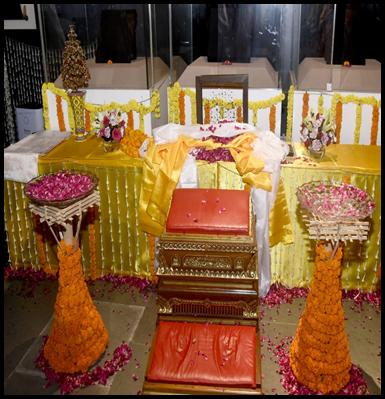
The journey of these relics, taken during colonial rule, came full circle in July 2025, as the Ministry of Culture, in collaboration with Godrej Industries Group, orchestrated their return. These relics had surfaced at an international auction—until a decisive intervention halted their sale and brought them back to their rightful home.
Unearthing the Sacred: Piprahwa Relics
The Piprahwa Relics are a collection of sacred artefacts discovered in 1898 at the Piprahwa Stupa in Uttar Pradesh, India. It is the site believed to be associated with ancient Kapilavastu, the homeland of Gautama Buddha.
These relics, unearthed by British colonial engineer William Claxton Peppé in 1898[1], include bone fragments believed to be those of Lord Buddha, along with crystal caskets, gold ornaments, gemstones, and a sandstone coffer.
An inscription in Brahmi script on one of the caskets links the relics directly to the Sakya clan, to which Buddha belonged, indicating that these remains were enshrined by his followers around the third century BC. Further excavations by the Archaeological Survey of India between 1971 and 1977 uncovered additional steatite caskets containing 22 sacred bone relics[2], which are now preserved at the National Museum in New Delhi.
Homecoming After 127 Years
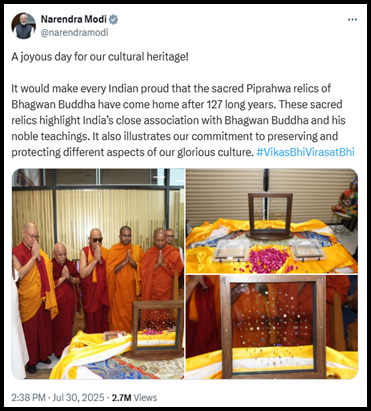
Prime Minister Narendra Modi celebrated the repatriation of the sacred Piprahwa relics of Lord Buddha to India after 127 years, describing it as a proud moment for the nation’s cultural heritage.
In a statement embodying the spirit of Vikas Bhi Virasat Bhi, he emphasized India’s deep reverence for Buddha’s teachings and its commitment to preserving its spiritual and historical legacy.
In a post on X, Prime Minister Narendra Modi noted that the relics, discovered in 1898 at Piprahwa but taken abroad during colonial times, were successfully brought back after appearing in an international auction earlier this year, thanks to concerted efforts. He expressed gratitude to all involved, highlighting the relics’ significance in showcasing India’s connection to Buddha and its dedication to safeguarding its cultural heritage[3].
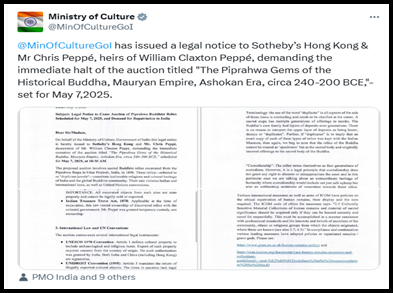
In May 2025, the Ministry of Culture intervened to halt an auction of a portion of the Piprahwa Relics by Sotheby’s in Hong Kong[4]. The relics were successfully repatriated to India on July 30, 2025, through a public-private partnership involving the Government of India and the Godrej Industries Group[5].
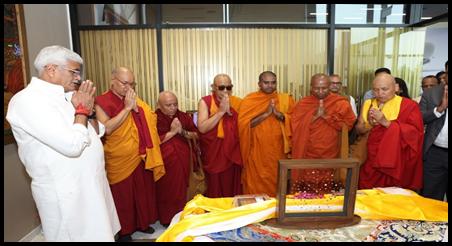
Pirojsha Godrej, Executive Vice Chairperson of Godrej Industries Group, expressed pride in contributing to this milestone, describing the Piprahwa relics as timeless symbols of peace, compassion, and humanity’s shared heritage. The successful repatriation, facilitated through a public-private partnership with the Government of India, sets a benchmark for cultural diplomacy and collaboration.
The relics will soon be unveiled in a public ceremony, allowing citizens and global visitors to connect with these sacred artifacts. This initiative reinforces India’s role as a global custodian of Buddhist values and cultural heritage, aligning with Prime Minister Modi’s mission to celebrate and reclaim Bharat’s ancient legacy.
India's Buddhist Heritage and Cultural Diplomacy
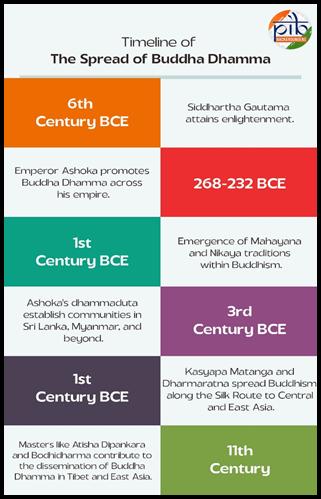
In the 6th century BCE, Siddhartha Gautama attained enlightenment, becoming the Buddha and initiating the spread of his teachings, known as Buddha Dhamma.
After his Mahaparinirvana, his followers preserved and propagated these teachings, leading to the development of three major Buddhist traditions: Theravada, Mahayana, and Vajrayana. Emperor Ashoka (268-232 BCE) significantly advanced Buddhism by integrating its principles into his governance, promoting peace and harmony, and spreading the teachings across Asia through his rock and pillar edicts.
As Buddhism expanded, it diversified into Mahayana and Nikaya schools, with Theravada as the sole surviving Nikaya school, and adapted to local cultures, forming the Northern branch in Central and East Asia and the Southern branch in Southeast Asia, fulfilling diverse spiritual needs across history.
India’s deep-rooted Buddhist heritage, stemming from the teachings of the Buddha and his followers, has significantly shaped its cultural identity and fostered unity across Asia by promoting shared values of life, divinity, and social harmony. This legacy strengthens India’s foreign policy and diplomatic relations, encouraging mutual respect and cooperation among nations.
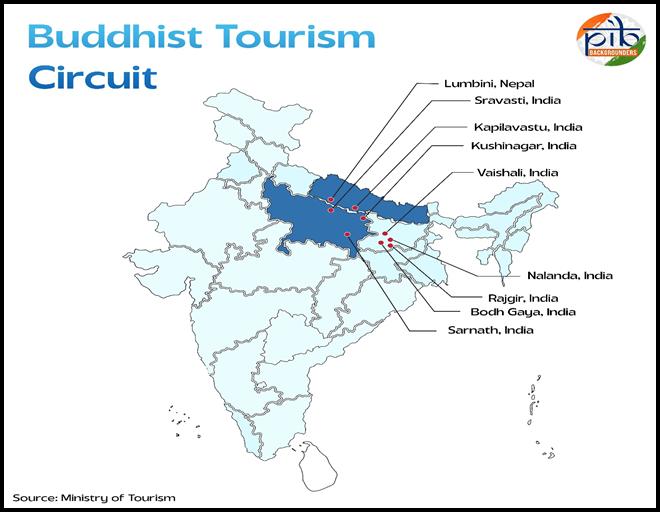
In order to preserve and promote this heritage, India has launched initiatives like the Buddhist Tourism Circuit under the Swadesh Darshan scheme, which develops key Buddhist sites such as Kapilvastu, enhancing cultural tourism and reinforcing India’s historical connection to Buddhism.
Buddhist Relics Fosters Cultural Ties
In the recent past, India facilitated significant cultural exchanges by showcasing Buddhist relics in Thailand and Vietnam for public veneration. This strengthens spiritual bonds across these nations. In Thailand, the relics of Lord Buddha and his disciples, Arahant Sariputra and Arahant Maudgalyayana, were displayed for 26 days across Bangkok, Chiang Mai, Ubon Ratchathani, and Krabi, attracting over four million devotees. Organized by India’s Ministry of Culture and the International Buddhist Confederation, this exposition underscored deep cultural connections.
Similarly, in Vietnam, a month-long exhibition featuring Buddha’s relics, including a portion of his skull bone, was held in Ho Chi Minh City, Tay Ninh, Hanoi, and Ha Nam as part of the UN Day of Vesak celebrations, drawing 17.8 million devotees. These events highlight the enduring spiritual and cultural ties uniting India, Thailand, and Vietnam through shared Buddhist heritage.
Additionally, in 2022, in a significant gesture towards the revival of cultural and spiritual ties between Indian and Mongolia, four Holy Relics of Lord Buddha were showcased in Mongolia for an 11-day public exposition. This event was organized to commemorate Mongolian Buddha Purnima, celebrated on June 14[6].
India, the cradle of Buddhism, demonstrates its unwavering commitment to preserving and promoting the Buddha Dhamma through government-organised events like summits and commemorative programs, ensuring the global spread of the Buddha’s teachings of peace, compassion, and mindfulness. The Ministry of Culture, Government of India, plays a pivotal role in fostering these initiatives, hosting significant gatherings celebrating Gautam Buddha’s life and teachings. These efforts highlight India’s dedication to nurturing Buddhism’s relevance, strengthening its spiritual legacy, and inspiring future generations worldwide.
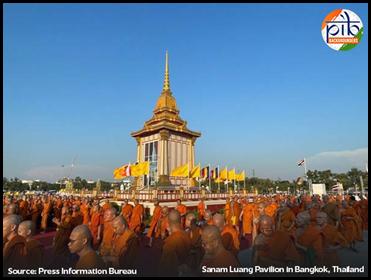
For instance, in the recent years, India hosted significant events to highlight its Buddhist heritage, including the Global Buddhist Summit (2023) and Asian Buddhist Summit (2024). In April 2023, the global summit was inaugurated by Prime Minister Shri Narendra Modi, which focused on universal values, peace, and sustainable models for global challenges. Similarly, in November 2024, the First Asian Buddhist Summit was organised with the collaborative effort of the Ministry of Culture and the International Buddhist Confederation in New Delhi. The event was themed ‘Role of Buddha Dhamma in strengthening Asia’ and witnessed the participation from 32 countries across the globe, with more than 160 international participants[7].
Moreover, since 2015, the Ministry of Culture (MoC) in India has been organising large-scale events to commemorate three significant days associated with the life of Lord Buddha: Vesak Day, Ashadha Poornima, and Abhidhamma Day.
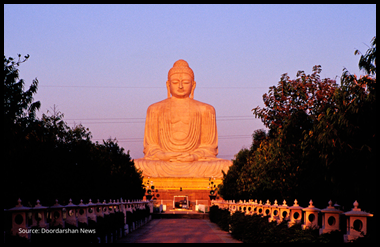
Vesak Day, also known as Buddha Purnima or Buddha Jayanti, is the most sacred Buddhist festival, celebrated on the full moon day of the Vaisakha month (typically April or May). It marks three pivotal events in Gautama Buddha’s life: his birth in Lumbini (circa 623 BCE), his enlightenment under the Bodhi tree in Bodhgaya, and his Mahaparinirvana (passing away) at Kushinagar at age 80. Prime Minister Shri Narendra Modi visited Colombo, Sri Lanka in May 2017 at the International Vesak Day celebrations highlighting that the day is to revere the birth, the enlightenment and the Parinibbana of Lord Buddha, the "Tathagatha"[8]. Similarly in 2021, Prime Minister Shri Narendra Modi delivered a virtual keynote address on the occasion of Vesak Global Celebrations on Buddha Purnima, attended by the Members of Venerated Mahasangha, Prime Ministers of Nepal and Sri Lanka, Union Ministers Shri Prahlad Singh and Shri Kiren Rijiju, Secretary General of International Buddhist Confederation, and Venerable Doctor Dhammapiya[9] reflecting upon the celebration of the life of Gautam Buddha, which was about peace, harmony, and co-existence.
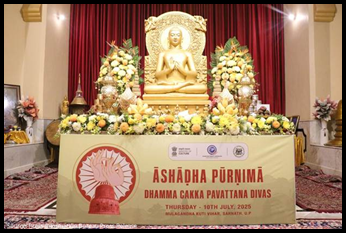
Ashadha Purnima, also known as Dharma Day, is celebrated on the full moon day of the eighth lunar month (usually July). It commemorates the Buddha’s first sermon, the “Turning of the Wheel of Dharma,” delivered to his five ascetic disciples at Sarnath after attaining enlightenment. This sermon introduced the Four Noble Truths and the Eightfold Path, laying the foundation for Buddhist teachings and the establishment of the monastic community (Sangha). In July 2025, the International Buddhist Confederation, in collaboration with the Ministry of Culture, Government of India, and the Mahabodhi Society of India, celebrated Ashadha Purnima at Sarnath’s Mulagandha Kuti Vihara, marking Dhammachakra Pravartana Divas—when Lord Buddha delivered his first sermon[10]. The event, attended by monastics, scholars, and devotees worldwide, began with a mindful parikrama around the Dhamek Stupa and signalled the start of Varsha Vassa, the monastic rains retreat, symbolizing introspection and spiritual growth, with the stupa radiating the timeless essence of Buddha’s teachings.
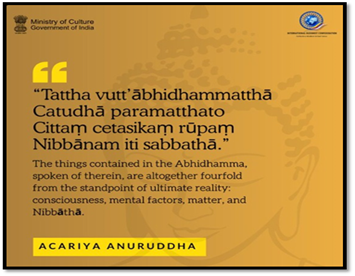
India, the birthplace of Buddhism, celebrates International Abhidhamma Divas to honor Lord Buddha’s profound philosophical teachings, particularly the Abhidhamma, which emphasizes mental discipline and self-awareness. This global observance commemorates Buddha’s descent from Tāvatiṃsa-devaloka to Sankisa (the present day Sankisa Basantapur, Uttar Pradesh), marked by the Asokan Elephant Pillar, where he taught the Abhidhamma to deities, including his mother, during the Rainy Retreat (Vassa). Held in New Delhi in 2024, the International Abhidamma Divas, supported by the Ministry of Culture, was graced by eminent dignitaries, witnessing around 1,000 participants, including ambassadors, monks, scholars, and young experts from 14 countries[11]. Prime Minister Shri Narendra Modi’s keynote address emphasized the continued relevance of Abhidhamma teachings and efforts to preserve Pali as a classical language.
Further solidifying its commitment to Buddhist heritage, India granted classical status to the Pali language on October 4, 2024, recognising its historical role as the medium of the Buddha’s sermons. The International Abhidhamma Divas on October 17, 2024, in New Delhi, attended by around 1,000 participants, including ambassadors and scholars, underscored the relevance of Abhidhamma teachings and Pali’s role in preserving the Buddha Dhamma. These initiatives collectively reflect India’s dedication to celebrating and preserving its Buddhist culture, fostering global dialogue, and promoting peace and harmony through shared heritage.
Conclusion
This homecoming is celebrated throughout the country as a triumph of India’s cultural heritage, emphasizing the government’s commitment to protecting these sacred artifacts. The relics, originally taken abroad during the colonial era, are now back in India, symbolizing the nation’s enduring connection to Buddha’s teachings.
References:
Press Information Bureau:
https://www.pib.gov.in/PressReleaseIframePage.aspx?PRID=2127159
https://www.pib.gov.in/PressReleasePage.aspx?PRID=2150352
https://www.pib.gov.in/PressReleasePage.aspx?PRID=2150093
https://www.pib.gov.in/PressReleasePage.aspx?PRID=2143880
https://static.pib.gov.in/WriteReadData/specificdocs/documents/2024/feb/doc2024220313101.pdf
https://www.pib.gov.in/PressReleaseIframePage.aspx?PRID=2072224
https://www.pib.gov.in/PressNoteDetails.aspx?NoteId=153285
Ministry of Information and Broadcasting:
https://www.newsonair.gov.in/sacred-piprahwa-relics-of-lord-buddha-return-home-after-127-years/
Ministry of Tourism and Culture:
https://tourism.gov.in/sites/default/files/2021-10/Buddhist%20Tourism%20Circuit%20in%20India_ani_English_Low%20res.pdf
Ministry of External Affairs:
https://www.mea.gov.in/Speeches-Statements.htm?dtl/28459/Address+by+Prime+Minister+at+International+Vesak+Day+celebrations+in+Colombo+May+12+2017
PM India:
https://www.pmindia.gov.in/en/news_updates/pm-delivers-keynote-address-on-the-occasion-of-vesak-global-celebrations/
Doordarshan News:
https://ddnews.gov.in/en/pm-modi-extends-greetings-on-buddha-purnima-hails-lord-buddhas-message-of-peace/
Click here to see pdf
****
RT/RK
(Backgrounder ID: 154972)
Visitor Counter : 39
Read this release in:
Hindi